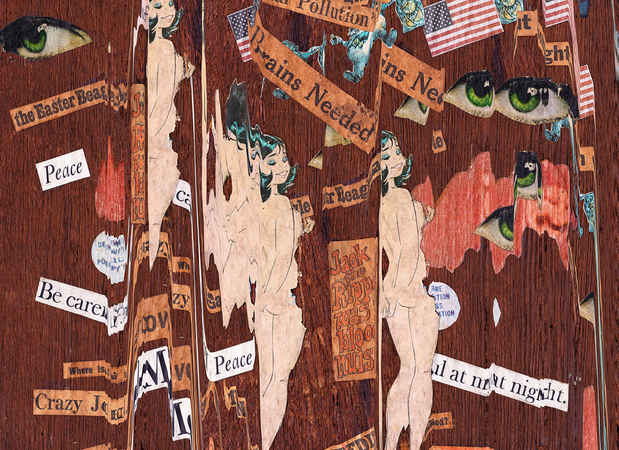Melanie Willhide “The Disquieting Muses Again”
Elizabeth Houston Gallery

[Image: Melanie Willhide "Brains Needed" (2017) archival pigment print, 20 x 27.5 in.]
This event has ended.
If the post-structuralists had ever penned their writings on chestnut beams, their graffiti might have looked much like Melanie Willhide’s The Disquieting Muses Again. A meditation on the construction of identity and desire, Willhide’s photographs of her uncle’s post-and-beam Connecticut mill—first erected in 1869—transform a reality already visibly mediated by language, and not to mention, weather. That there are “no real unaffiliated surfaces,” as Willhide puts it, is as true of the collection of countless paintings within the old mill and the collaged beams that buttress it as it is of the artist’s own images of the space. All objects, we find, are already more than their material substrate.
First a silk ribbon factory, and later an auto parts distribution center and furniture warehouse, the two-story brick mill underwent an unlikely metamorphosis in 2003 into an eccentric uncle’s artist loft and studio. Willhide’s subject bears the inscriptions of its history in the deliberate marks of those who have passed through its doors. If we expect warehouse workers of the 1960s to live up to our rugged stereotypes, then we may not be surprised by the naked women cutouts from Playboy and Time Life Magazine that adorn the mill’s posts. Their proclamations “Girls Are For Loving” and “Kisses”—text trimmed from the pages of magazines—are paired with the obscene scribblings of a studio assistant with a crude and violent imagination.
That those textual additions were made many years later is a fact lost in Willhide’s photos as they collapse time into one ruddy surface. The line between desire and violence, already a shaky one, is further obscured in the artist’s scans of her unknown collaborators’ work. In “editing their edit” of desire, and the masculine identity that comes into being through its images, the artist uncannily turns the gender of the space itself upside-down. Her process is somewhat more complicated than converting a silk ribbon factory into an automotive warehouse. Choreographing a scanner’s movement around the four sides of the mill’s beams, Willhide acknowledges the space itself as a form of art-making. But her resulting images reshape a masculine ideal of femininity, repurposing it for her own transgressive expression.
It is a clever reformulation of the idea of the muse. Perhaps Willhide is aware of the symbolic conflation in psychoanalytic theory of the house—its windows, doors, and rooms—with the female body. But whether she is or not, her process is both a collaboration across time and a reassertion of women’s own realities and creative power. We might be tempted to believe the subject of Willhide’s work to be the men who have come and gone through the space, those who have been fixated in turn on women’s eyes and mouths and bodies, but whose own bodies appear to be absent.
For Willhide, “desire is messy.” Its politics are not always as correct as cutouts of the US flag or Abraham Lincoln. The text in one of her photographs “Be Careful at Night” reads as both a bit of concerned advice and a deliberate warning, appearing alongside a headline about Jack the Ripper. But the messiness of desire also inheres in the disintegration of an ideal.
Willhide’s Disquieting Muses appear to be activated through the similarly messy force of nature on the wooden beams and canvases of paintings her uncle obsessively collects. Photographed by Willhide with a 4x5 camera, the recto and verso of each portrait are sandwiched together as negatives to produce each print. Willhide backlights the canvases, capturing the decay and disintegration of their surfaces over time. The women pictured in her uncle’s paintings, as in the workers’ collages, ultimately reject the fantasies projected onto them.
There is an element of wabi-sabi that informs their aesthetic and Willhide’s, allowing the artist’s appropriated muse to reassert herself as imperfect and impermanent, a vision of gender that cannot ever be achieved in reality. Instead, we find the surfaces of canvas, collage, and print, already distorted by desire and nature, to be more complicated and more beautiful still.
In her collaboration across time with unknown authors and ecological processes, Willhide inverts the gaze fixed by men on women. Her work approximates the forensic in its examination of her male collaborators. Just as the muses on the beams and canvases ultimately escape the forced ideal through their material deterioration, so too do the gender norms of desire and identity articulated by the space. We are never the image that others have of us. Nor should we be. As The Disquieting Muses Again ultimately reveals, we are already so much more than that.
- Robyn Day is a Chicago-based photographer and Communications Manager at the Carl & Marilynn Thoma Art Foundation. Day’s art criticism has been published in The ARTery at WBUR, Boston’s NPR news station; Art New England; Big Red & Shiny; Ain’t Bad Magazine; and Sixty Inches from Center.
Media
Schedule
from October 18, 2017 to December 09, 2017
Opening Reception on 2017-10-18 from 18:00 to 20:00